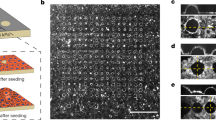Abstract
A theoretical model is presented for pattern formation in an epithelium. The epithelial model consists of a thin, incompressible, viscoelastic membrane on an elastic foundation (substrate), with the component cells assumed to have active contractile properties similar to those of smooth muscle. The analysis includes the effects of large strains and material nonlinearity, and the governing equations were solved using finite differences. Deformation patterns form when the cells activate while lying on the descending limb of their total (active + passive) stress-stretch curve. Various one-dimensional and two-dimensional simulations illustrate the effects of spatial and temporal variations in passive stiffness, as well as the effects of foundation stiffness and stretch activation. The model can be used to examine the mechanical aspects of pattern formation in morphogenetic processes such as angiogenesis and myocardial trabeculation.
Similar content being viewed by others
REFERENCES
Brodland, G.W. and D.A. Clausi (1994). Embryonic Tissue Morphogenesis Modelled by FEM. Journal of Biomechanical Engineering 116: 146–155.
Burnside, B. (1973). Microtubules and Microfilaments in Amphibian Neurulation American Zoology 13: 989–1006.
Celia, M.A. and W.G. Gray (1992). Numerical Methods for Differential Equations, Englewood Cliffs, N.J.: Prentice-Hall.
Eringen, A.C. (1962). Nonlinear Theory of Continuous Media, New York: McGraw-Hill.
Ettensohn, C.A. (1985). Mechanisms of Epithelial Invagination. Quarterly Review of Biology 60: 289–307.
Folkman, J. and C. Haudenschild (1980). Angiogenesis In Vitro. Nature 288: 551–556.
Forgacs, G., R.A. Foty, Y. Shafrir and M.S. Steinberg (1998). Viscoelastic Properties of Living Embryonic Tissues: a Quantitative Study. Biophysical Journal 74: 2227–2234.
Fristrom, D. (1988). The Cellular Basis of Epithelial Morphogenesis. A Review. Tissue & Cell 20: 645–690.
Fung, Y.C. (1997). Biodynamics: Circulation, Second Ed., New York: Springer.
Gordon, R. and G.W. Brodland (1987). The Cytoskeletal Mechanics of Brain Morphogenesis. Cell State Splitters Cause Primary Neural Induction. Cell Biophysics 11: 177–238.
Hiruma, T. and R. Hirakow (1985). An Ultrastructural Topographical Study on Myofibrillogenesis in the Heart of the Chick Embryo during Pulsation Onset Period. Anatomy and Embryology 172: 325–329.
Manasek, F.J. (1970). Histogenesis of the Embryonic Myocardium. American Journal of Cardiology 25: 149–168.
Manoussaki, D., S.R. Lubkin, R.B. Vernon and J.D. Murray (1996). A Mechanical Model for the Formation of Vascular Networks In Vitro. Acta Biotheoretica 44: 271–282.
Miller, C.E., M.A. Vanni, L.A. Taber and B.B. Keller (1997). Passive Stress-Strain Measurements in the Stage-16 and Stage-18 Embryonic Chick Heart. Journal of Biomechanical Engineering 119: 445–451.
Murray, J.D. (1993). Mathematical Biology, 2nd Ed., New York: Springer-Verlag.
Nagorcka, B.N., V.S. Manoranjan and J.D. Murray (1987). Complex Spatial Patterns from Tissue Interactions — an Illustrative Model. Journal of Theoretical Biology 128: 359–374.
Odell, G.M., G. Oster, P. Alberch and B. Burnside (1981). The Mechanical Basis of Morphogenesis. I. Epithelial Folding and Invagination. Developmental Biology 85: 446–462.
Oster, G. and P. Alberch (1982). Evolution and Bifurcation of Developmental Programs. Evolution 36: 444–459.
Oster, G.F., J.D. Murray and A.K. Harris (1983). Mechanical Aspects of Mesenchymal Morphogenesis. Journal of Embryology and Experimental Morphology 78: 83–125.
Taber, L.A., B.B. Keller and E.B. Clark (1992). Cardiac Mechanics in the Stage-16 Chick Embryo. Journal of Biomechanical Engineering 114: 427–434.
Turing, A.M. (1952). The Chemical Basis of Morphogenesis. Philosophical Transactions of the Royal Society, London B237: 37–72.
Zahalak, G.I. (1997). Can Muscle Fibers Be Stable on the Descending Limbs of Their Sarcomere Length-Tension Relations? Journal of Biomechanics 30: 1179–1182.
Author information
Authors and Affiliations
Rights and permissions
About this article
Cite this article
Taber, L.A. Pattern Formation in a Nonlinear Membrane Model for Epithelial Morphogenesis. Acta Biotheor 48, 47–63 (2000). https://doi.org/10.1023/A:1002691300115
Issue Date:
DOI: https://doi.org/10.1023/A:1002691300115




